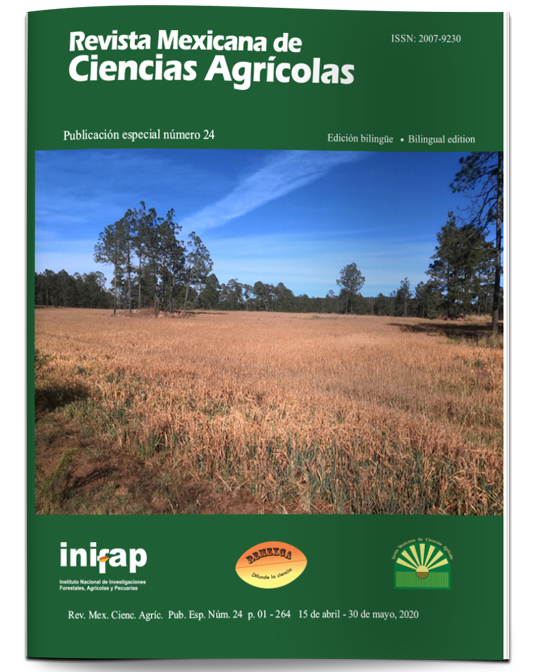Nopal clones Oreja de Elefante Mexicana with forage potential
DOI:
https://doi.org/10.29312/remexca.v0i24.2373Keywords:
clones, forage potential, nopal, Semiarid BrazilianAbstract
In order to evaluate, among clones of the Oreja de Elefante Mexicana nopal cultivar (Opuntia stricta Haw), the one that indicated agronomic and zootechnical characteristics to be considered with forage potential, an experiment was carried out at the Agronomic Institute of Pernambuco (IPA), located at coordinates 08° 25’ 15’’ south latitude and 37° 03’ 41’’ west longitude, at 663 meters above sea level, with a precipitation of 692 mm. The experimental period was from January 2014 to July 2015 and the clones used were Lisa 1, Lisa 2, Seg CV, mãe plant, Seg 1, Seg 2, Seg 3, Seg 4, Seg 5 and Seg 6. The variables evaluated were production (t DM ha-1), number of cladodes in plant (NC), plant height (PH), plant width (PWI), amount of thorn (AT), size of thorn (ST) and amount of gloquide (AG); within each plant it was measured in cladodes, perimeter (P), length (LC), width (WID) and thickness (TH), number of lines (NLI) and number of buds (NBU). The experimental design was completely random and the test of comparison of means with Tukey (p≤ 0.05). There were differences between clones (p≤ 0.05); Lisa 2, showed the lowest AT, ST, AG, and the lowest production (6.45 t DM ha-1), the Seg CV clone, showed higher production (67.41 t DM ha-1), NC, PH, and PWI, without However, it also presented higher AT, ST and AG, so despite its yield it does not show the best agronomic and zootechnical characteristics.
Downloads
Downloads
Published
How to Cite
Issue
Section
License
The authors who publish in Revista Mexicana de Ciencias Agrícolas accept the following conditions:
In accordance with copyright laws, Revista Mexicana de Ciencias Agrícolas recognizes and respects the authors’ moral right and ownership of property rights which will be transferred to the journal for dissemination in open access. Invariably, all the authors have to sign a letter of transfer of property rights and of originality of the article to Instituto Nacional de Investigaciones Forestales, Agrícolas y Pecuarias (INIFAP) [National Institute of Forestry, Agricultural and Livestock Research]. The author(s) must pay a fee for the reception of articles before proceeding to editorial review.
All the texts published by Revista Mexicana de Ciencias Agrícolas —with no exception— are distributed under a Creative Commons License Attribution-NonCommercial 4.0 International (CC BY-NC 4.0), which allows third parties to use the publication as long as the work’s authorship and its first publication in this journal are mentioned.
The author(s) can enter into independent and additional contractual agreements for the nonexclusive distribution of the version of the article published in Revista Mexicana de Ciencias Agrícolas (for example include it into an institutional repository or publish it in a book) as long as it is clearly and explicitly indicated that the work was published for the first time in Revista Mexicana de Ciencias Agrícolas.
For all the above, the authors shall send the Letter-transfer of Property Rights for the first publication duly filled in and signed by the author(s). This form must be sent as a PDF file to: revista_atm@yahoo.com.mx; cienciasagricola@inifap.gob.mx; remexca2017@gmail.
This work is licensed under a Creative Commons Attribution-Noncommercial 4.0 International license.



